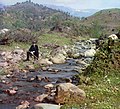Category talk:1895 black and white portrait photographs of men
Jump to navigation
Jump to search
This discussion of one or several categories is now closed. Please do not make any edits to this archive.
Category:1895 black and white portrait photographs of men[edit]
This doesn't make sense, as there is no color photography from 1895. All these categories (up to the end of WWI) should be reverted and deleted. Yann (talk) 10:59, 2 January 2023 (UTC)
- @Yann: I have already given examples of color photography on my talk page some of which were "real". Here of some from the Wikipedia page about color photography which are all "real".
Sahaib (talk) 11:07, 2 January 2023 (UTC)
- I wrote up to the end of WWI. Most of your examples are past that date. Yann (talk) 11:11, 2 January 2023 (UTC)
- Also I would not consider photographs that have been hand coloured to be "fake" such as File:Amundsen ombord. Gjöa 1903.1906. (9471830966).jpg because it is technically not black and white and so it does not matter if it is "real". Sahaib (talk) 11:15, 2 January 2023 (UTC)
- Yes, it matters. This is not a color photograph. It is a black and whote picture colored by hand, a totally different process. Yann (talk) 11:19, 2 January 2023 (UTC)
- I have found an entire category of images like these Category:Early colour photographs. Also 1918 is an arbitrary date. Sahaib (talk) 12:42, 2 January 2023 (UTC)
- Yes, it matters. This is not a color photograph. It is a black and whote picture colored by hand, a totally different process. Yann (talk) 11:19, 2 January 2023 (UTC)
- Also I would not consider photographs that have been hand coloured to be "fake" such as File:Amundsen ombord. Gjöa 1903.1906. (9471830966).jpg because it is technically not black and white and so it does not matter if it is "real". Sahaib (talk) 11:15, 2 January 2023 (UTC)
- I wrote up to the end of WWI. Most of your examples are past that date. Yann (talk) 11:11, 2 January 2023 (UTC)
- Weak keep. It seems like there is a use as there may exist non-BW photographs. I'm not sure why there is a separate category for black and white versus non-black and white photographs but it's been around forever. -- Ricky81682 (talk) 03:52, 14 January 2023 (UTC)
- Weak keep. I am a prolific uploader of early black-and-white and sepia photographs. So the issue that I have had with this category (and any other category in respect of black-and-white photos) is that the black-and-white photography process and appearance, and sepia photography process and appearance were not the same, up to about 1930 when colour photography became more common. Sepia photography process uses ink (called sepia) from the cuttlefish. The prints from sepia photography look brown, not black. The sepia process allowed a softer and more subtle variation of tone, which made a huge difference in portraits. The best photographers loved it, and there are loads of very fine sepia photos on the National Portrait Gallery website. But unfortunately, some Commons editors are colour-blind, and it is difficult for them to differentiate between black-and-white prints and sepia prints. My own son is colour-blind, but he would normally ask friends for help if categorising black and white photographs in order to separate them from other colourways. So may I suggest that if you are colour-blind, and you are reading this page, please consider asking friends for help with this particular type of categorisation? That would save me re-categorising so many of my uploads. Thank you. Storye book (talk) 10:23, 17 January 2023 (UTC)
![]() Question @Yann: There does not seem to be a consensus here to delete these categories and no new discussion for the last month. Do you mind if we close this one, or is there more to add to the discussion? Josh (talk) 07:09, 19 February 2023 (UTC)
Question @Yann: There does not seem to be a consensus here to delete these categories and no new discussion for the last month. Do you mind if we close this one, or is there more to add to the discussion? Josh (talk) 07:09, 19 February 2023 (UTC)
- OK, fine. Yann (talk) 08:41, 19 February 2023 (UTC)
| This category discussion has been closed. | ||||
|---|---|---|---|---|
| Consensus | ||||
| Actions | ||||
| Participants | ||||
| Closed by | Josh (talk) 21:44, 24 February 2023 (UTC) | |||












